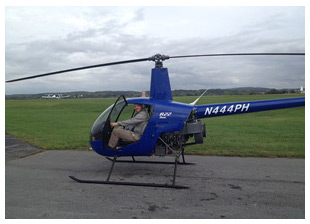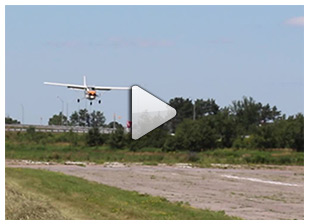Training Tips
|

You rely on performance charts and lots of practice to learn what can be expected from your trainer during takeoff, landing, cruise, or when demonstrating a maneuver.
Many variables affect the published performance figures: If a runway isn't level, or the grass isn't dry, adjust ground-roll values for takeoff or landing, using side notes often published along with the charted data.
How far will your aircraft glide after an engine failure? That also depends on many factors, including how promptly and precisely you establish the recommended airspeed. According to the pilot's operating handbook for a 1978 Cessna 172N, published maximum glide distance figures are based on four conditions: speed 65 knots indicated airspeed, the propeller windmilling, flaps up, and zero wind.
Airspeed and flaps you can control, but the likelihood of zero wind is remote. And what exactly—as your designated pilot examiner might inquire—is a "windmilling" propeller?
A propeller is windmilling, says the glossary section of the Airplane Flying Handbook, when the air moving through it "creates the rotational energy."
Here's the catch: Not every kind of engine failure would result in a windmilling propeller. A seized engine, for example, would bring the prop to a complete stop.
So here's another question a designated examiner might ask a flight-test applicant: Which condition is worse for glide performance—a windmilling propeller, or a stopped prop?
The answer is that windmilling is worse. That helps explain why pilots of aircraft with constant-speed propellers are taught to place the prop in the low-rpm (high-pitch) setting for a glide with a windmilling prop.
"In some high-performance singles, the decrease in drag is so dramatic that you literally feel the airplane accelerate as you pull back the propeller-pitch control (and vice versa). Don't do this, of course, unless the engine has failed or is idling," wrote Barry Schiff in his "Proficient Pilot" column. Does it matter to glide performance if a two-bladed prop stops in the vertical or horizontal position? See the column for the answer.
Safety dictates practicing simulated engine failures at idle power and the prop windmilling. Be sure to use carb heat, and clear the engine frequently during the simulation. Accidents have resulted from overlooking carb heat, and from cases where an engine was intentionally shut down during a simulation, and could not be restarted.
|
|
Flight Training News
|

Advocacy
An industry-led working group co-chaired by AOPA has released a set of recommendations designed to make pilot testing and training more relevant. The recommendations would affect applicants for the instrument rating and private, commercial, and instructor certificates.
Read more...
Share:
 
Fly like a fighter
Variable gusting winds can force a runway change on short notice. Pilots should be prepared to switch runways even on short final, as retired Air Force fighter pilot Larry Brown recounts from his training at the Air Force Academy.
Read more...
Share:
 

Rotorcraft Rookie
A longtime fixed-wing pilot takes his first step to learning how to fly helicopters.
Read more...
Share:
 
Answers for Pilots
The holidays are here! It's wonderful. It's memorable. It's exhausting! If you are planning a family trip, it's natural to focus more on the family than on the flying, but that distraction can lead to accidents. Here are some recommendations for pilots flying for the holidays.
Read more...
Share:
 

Article
This week AOPA highlights five random apps, covering everything from fuel calculations to an addictive air traffic control game.
Read more...
Share:
 
The Experimental Aircraft Association has announced plans to expand the College Park area at EAA AirVenture 2014. The park debuted in 2013 and featured dozens of aviation colleges and universities, along with a college night for high school and college-age students exploring aviation education. In 2014 it will include an aviation careers exhibit area and more opportunities for those seeking aviation careers and job openings.
The University of Cincinnati Research Institute (UCRI) and GE Aviation have created the GE Aviation Research Center. The new center will allow GE Aviation engineers and UC faculty working through the institute to pursue innovations with direct application on future aviation products being developed at GE. It will also be a place for UC students to gain experience.

Video
Energy management is crucial for short-field landings, and their techniques differ from normal landings for a reason. To avoid confusion, sometimes it helps to take on a broader view of why these differences are important.
Watch the video...
Share:
 
Ice Week
Missed the Air Safety Institute's Ice Week? You can still participate: See the videos, watch the recorded webinar, and take the Ice Flight quiz. In this first installment of the Air Safety Institute's Flying the Weather video series, you'll appreciate the danger of airframe icing as AOPA Pilot Editor at Large Tom Horne discusses how airframe ice affects the aircraft's handling and that all-important facet of flying, lift.
Read more...
Share:
 
|
Training Resources
|
|
PDF
Winter flying brings the potential for encountering icing conditions in flight. Do you know how to anticipate areas of probable icing? Is your aircraft's anti-icing equipment enough to provide safe flight through ice-laden air? How can you know if your aircraft is accumulating ice on areas you can't see, like the propeller or the tail? This Air Safety Institute Safety Advisor discusses icing and provides tips on how to avoid this potentially deadly foe.
Download the PDF...
|
|
Did you know that student pilots who join AOPA are three times more likely to complete their flight training? Membership includes unlimited access to aviation information by phone (800/USA-AOPA, weekdays from 8:30 a.m. to 8 p.m. Eastern time) or from Flight Training Online or AOPA Online. If you're not already a member, join today and get the pilot's edge.
|
AOPA Live
|
|
AOPA Live This Week
The pilot of the lead aircraft in a formation skydiving drop speaks to AOPA Live about escaping from the badly damaged Cessna 182 after a midair collision, and a Beech 18 on straight floats flies across the country in this week's episode of AOPA Live This Week. As of publication deadline, AOPA Live producers were still finalizing the show, which will be available Nov. 15.
AOPA Live This Week®...
Share:
 
|
|
Career Pilot
|
|
Alaska Airlines said Oct. 28 that it will install a new, performance-enhancing winglet on its Boeing Next Generation 737s that will save $20 million in fuel costs each year. Designed by Seattle-based Aviation Partners Boeing, the first winglet will be installed in early 2014, and 111 aircraft will have them by 2017. The split scimitar winglets add new strengthened spars, aerodynamic scimitar tips, and a large ventral strake to the existing blended winglet structure.
Longview, Texas-based LeTourneau University and American Eagle Airlines have signed an agreement that will provide a direct pathway for the school's flight students to fly for the carrier after graduation. The candidate must meet the university's requirements as a certificated flight instructor and continue to meet them while instructing for the university. If LETU does not have a CFI position available, American Eagle will attempt to place the candidate in a position with another flight school affiliated with the program.
|
|
For more aviation career news, see the Flight Training website.
|
Plane Spotter
|

It's a 3,000-pound, turbine-powered helicopter that its manufacturer says "blows a dust storm on the competition" when it comes to operating costs. With any luck, that dust cloud won't obscure a plane spotter's view of any Enstrom 480B arriving at the local airport. Look for a five-seat cabin, high skids, three main rotor blades, hefty vertical boom fins, and an "unblocked tail rotor" that Enstrom incorporates in its piston and turbine aircraft designs to combat LTE (loss of tail-rotor effectiveness). Enstrom Helicopters is located in Menominee, in Michigan's Upper Peninsula.
|
Training Products
|
|
Stuck Mic AvCast, in collaboration with Expert Aviator, recently announced the release of a new online course called the Practical Guide to Winter Flying. Created with safety in mind and to increase pilot skill level, this course teaches how to manage encounters with ground and in-flight icing during the upcoming cold winter months. The cost is $67.
The second edition of Aircraft Systems: What you need to know about how your airplane works, is now available at PilotMall.com. Author David A. Lombardo offers readers a thoroughly illustrated tour of the systems that make an airplane work, giving step-by-step procedures and troubleshooting tips that improve safety and cut risk. The cost is $29.99.
|
|
Note: Products listed have not been evaluated by ePilot editors unless otherwise noted. AOPA assumes no responsibility for products or services listed or for claims or actions by manufacturers or vendors.
|
Member Benefits
|
|
Members only
Diabetes mellitus that is controlled by diet and exercise does not require a special issuance, so your aviation medical examiner may issue a medical certificate without approval from the FAA. However, you will need some documentation for your AME at the time of your next FAA physical examination.
Read more...
Share:
 
|
Blogs
|
|
Several months ago, Opinion Leaders blogger Ron Rapp mused about the how ever-advancing computer technology has led to a marked improvement in simulators for the light general aviation market. After his post was published, reader Keith Smith alerted him to a corresponding service he had developed called PilotEdge.
Read more...
Share:
 
An airline job interview is generally a one-way conversation, with the airline asking all the questions, and you doing your best to get the job. However, you should also be ready and willing to ask certain questions that will affect your future.
Read more...
Share:
 
|
|
|
Instrument Tip
|
|
IFR Fix
The pilot attributed his errant decision making to "my determination not to disappoint a friend." Has your determination not to disappoint a passenger in your aircraft ever degraded your piloting judgment, putting you in a tight spot? Share your lessons learned.
Read more...
Share:
 
|
Final Exam
|
Question
Even if you wait the required eight hours after consuming your last alcoholic beverage, your alcohol concentration must be below what level to fly legally?
Answer
In a blood or breath specimen, the alcohol concentration must be below 0.04. Alcohol concentration means grams of alcohol per deciliter of blood or grams of alcohol per 210 liters of breath. If a person is under the influence of alcohol, that person may not act as a crewmember of an aircraft. (Source: FAR § 91.17.)
|
|
Got a question for our technical services staff? Contact AOPA.
|
AOPA Career Opportunities
|
Ever dream of turning your passion for aviation into a career? We're looking for a financial analyst and staff assistant/PAC coordinator. To learn more about other AOPA career opportunities,
visit AOPA Online.
|
 |
Education and Seminars
|
Flight Instructor Refresher Courses
Nov 16-17 - San Diego, Calif.
Nov 23-24 - Albuquerque, N.M.
Dec 7-8 - Denver, Colo.; Orlando, Fla.; and Northbrook, Ill.
Jan 4-5 - Ypsilanti, Mich.; Portland, Ore.; San Jose, Calif.; and San Antonio, Texas
For a complete schedule, see AOPA Online. Can't make it in person? Sign up for the Air Safety Institute's new Online eFIRC.
|
|
|
|
|
|
 |
|
|
ePilot Flight Training Editor:
Benét Wilson
Production Team
Katie Richardson
Lezlie Ramsey
Melissa Whitehouse |
Contributors:
Sarah Deener
Alyssa Miller
Jim Moore
Jill W. Tallman
Warren Morningstar
Alton K. Marsh
Dave Hirschman
Tom Horne
Ian J. Twombly
Dan Namowitz |
|
|
|
|